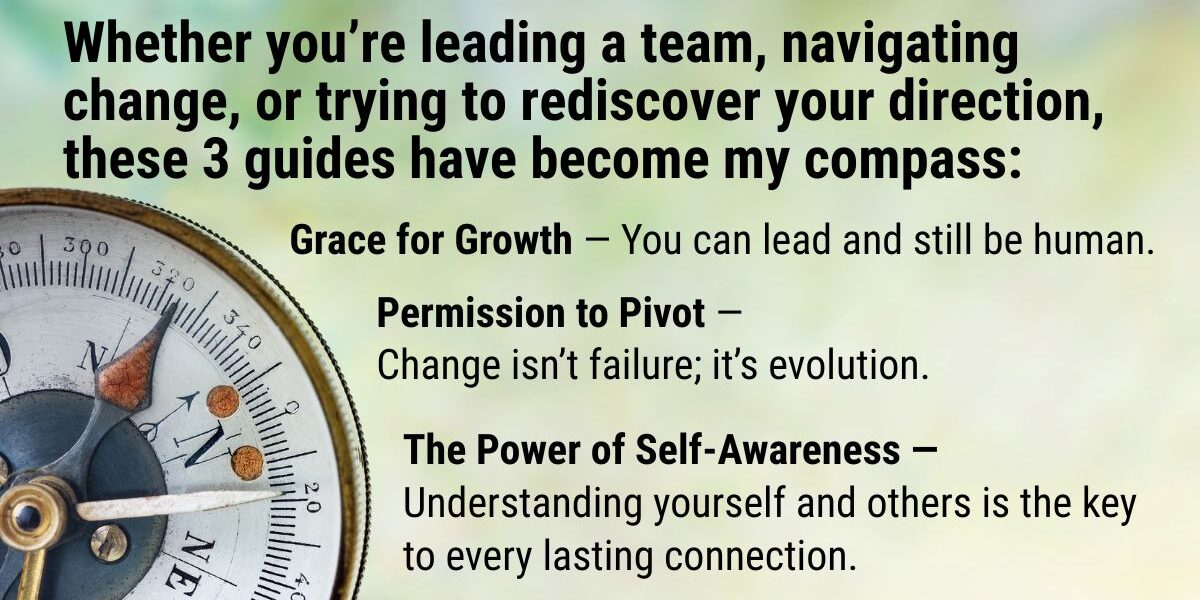Recently, I sat down with John Stange on the Online Business Blueprint podcast to talk about how understanding personality styles can transform the way we lead and connect. I’ve spent over 20 years using DISC to improve communication—both at home and in business—and I’ve seen firsthand how it deepens empathy, strengthens teams, and creates harmony in relationships.
It’s something I’ve worked with since childhood—literally. When I was twelve, my mom (Joanne Miller) gave me a creative writing assignment about personality styles that she and dad (Dan Miller) had me read to their Sunday school class.
Decades later, I still believe that understanding personality styles is one of the most powerful ways we can improve our relationships, our work, and our ability to lead—both others and ourselves.
In the podcast, we talked about what DISC reveals, not just about behavior, but about how we handle growth and change. Here are three guides that continue to shape my own journey:
1. Grace for Growth — Leading as a Human, Not a Hero
After my father’s passing, I found myself in a season of deep transition. I was running a thriving community within 48 Days, but inside, I was exhausted and grieving.
So I made a hard decision: I closed it down.
It wasn’t the “business-smart” move—it was the human one. Because leadership isn’t about pretending to have it all together; it’s about leading with honesty and integrity, even when you’re hurting.
That’s what I mean when I talk about grace for growth. We all have moments where we need to pause, recalibrate, or simply breathe.
When we start using DISC to improve communication and empathy, we see why that’s so different for everyone.
- A D (Dominant) personality may need grace to slow down—to remember that relationships matter as much as results.
- An I (Inspiring) may need grace to focus—to turn enthusiasm into sustainable action.
- An S (Supportive) may need grace to speak up—to voice their own needs instead of always keeping the peace.
- A C (Conscientious) may need grace to let go—to trust progress over perfection.
Grace for growth isn’t about letting ourselves off the hook. It’s about allowing ourselves to be human while we grow.
2. Permission to Pivot — Understanding Change Through Personality
John asked me during the podcast, “Why do we struggle so much to pivot?”
It’s a great question—and one I’ve seen come up again and again in my coaching. The truth is, some people are energized by change. Others are deeply unsettled by it. And much of that comes down to our wiring.
If you’re familiar with using DISC to improve communication:
- D’s love new challenges and often initiate change.
- I’s are inspired by new ideas but can get distracted mid-pivot.
- S’s crave stability — so change feels like loss of security.
- C’s want every variable analyzed before they move.
Knowing this doesn’t box you in—it empowers you.
When you understand how you respond to change, you can navigate it more intentionally. You can create small anchors that bring security in transition—a morning routine, journaling, prayer, or time outside.
Pivoting doesn’t mean you failed. It means you’re paying attention.
For me, permission to pivot looked like stepping away from the familiar “way things were” at 48 Days and creating the next evolution—The Eagle Alliance—with a focus on deeper connection, family alignment, and community over noise.
3. The Power of Self-Awareness — Speaking the Language of Empathy
At its core, the DISC model isn’t about labels. It’s about language.
It helps us understand how people communicate, what motivates them, and what shuts them down. When we use DISC as a tool for empathy, it changes how we interact—not just at work, but at home, in marriage, and in community.
“The uniqueness in each of us strengthens all of us.”
That’s been my guiding principle for years.
When we learn to appreciate the differences in others—instead of being frustrated by them—we create synergy. We get better results and stronger relationships.
If you’re a leader, parent, or partner, using DISC to improve communication gives you a way to see beyond behavior and into the heart behind it. It invites us to slow down long enough to ask, “What does this person need right now—to feel valued, safe, or understood?”
That’s not just communication. That’s connection.
Bringing It All Together
Whether you’re leading a team, navigating change, or trying to rediscover your direction, these three guides have become my compass:
- Grace for Growth—You can lead and still be human.
- Permission to Pivot—Change isn’t failure; it’s evolution.
- The Power of Self-Awareness—Understanding yourself and others is the key to every lasting connection.
In the podcast, John and I talked about how these principles have shaped the way I lead, coach, and parent. They’ve also reshaped how I define success—not as constant forward motion, but as meaningful movement in alignment with who I am and who I’m becoming.
Because leadership—and life—isn’t about having it all figured out.
It’s about learning the language of empathy, giving yourself grace, and having the courage to pivot when your heart says it’s time.
Listen to the full conversation
You can listen to my full conversation with John Stange on the Online Business Blueprint podcast.
And if you want a simple way to start learning the language of empathy, grab your own personality profile.
Get one for your whole team or family with a bulk discount.
Because when we understand ourselves better, we show up better — and that’s how we build legacies that last.







